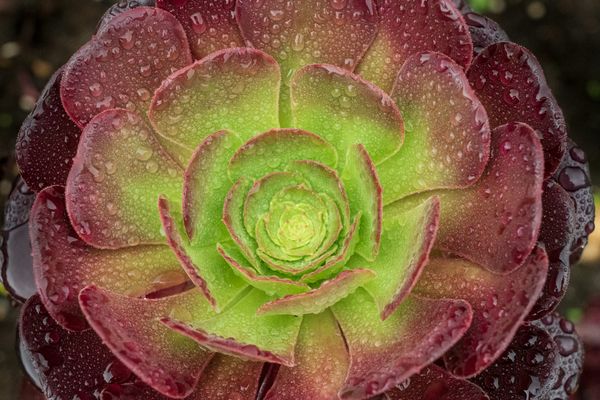Tree Aeonium Care Guide
How to grow and care for Tree Aeonium (Aeonium arboreum)
The Aeonium arboreum, commonly known as the Tree Aeonium, is a delightful succulent native to the Canary Islands. With its lush, rosette-forming leaves and vibrant colors, this plant adds an exotic touch to any indoor collection. Its striking appearance is matched by its ease of care, making it a popular choice for both novice and experienced indoor gardeners. Perfect for a sunny spot in your home, the Tree Aeonium is as hardy as it is beautiful.

Disclosure: This content includes affiliate links, which means we may earn a commission if you click on a link and make a purchase. As an Amazon Associate, we earn from qualifying purchases. This comes at no extra cost to you and helps offset the cost of running Leafwise. Please read our disclaimer for more info.
Table of Contents
Care
Light
Aeonium arboreum thrives in bright, indirect sunlight. Aim for at least six hours of light daily to maintain its vivid leaf color and healthy growth. While it can tolerate some direct sun—particularly in cooler climates—harsh afternoon sunlight in summer may cause leaf scorch. In warmer regions, consider using filtered light or partial shade during peak sun hours. If natural light is limited, supplement with a grow light.
Temperature & Humidity
Aeonium arboreum prefers moderate temperatures between 65–75°F (18–24°C). It can tolerate occasional drops to 40°F (4°C) but should be protected from frost. Indoors, keep the plant away from cold drafts or heat sources. This succulent adapts well to average household humidity and does not require additional moisture.
Watering
Although Aeonium arboreum enjoys slightly more moisture than some succulents, it still benefits from the "soak and dry" method. Water thoroughly, let excess drain, and allow the soil to dry completely before watering again. During the active growing seasons (spring and fall), water every two to three weeks. In summer, the plant enters dormancy—growth slows, and some leaves may drop—so reduce watering significantly. Always adjust based on your environment’s humidity and temperature.
Soil
Use a well-draining cactus or succulent potting mix to prevent water retention and reduce the risk of root rot. You can also create your own mix by blending regular potting soil with coarse sand or perlite.
Maintenance
Pruning
Prune as needed to remove dead or yellowing leaves and encourage a bushier appearance. Pruning can be done year-round, but expect slower regrowth during the plant’s summer dormancy.
Cleaning
Dust may accumulate on Aeonium leaves, particularly indoors. Use a soft brush or cloth to gently remove dust and debris, improving light absorption and deterring pests.
Rotation
Rotate the plant every couple of weeks to ensure all sides receive equal light. This encourages balanced growth and helps prevent legginess.
Repotting
Repot every 2–3 years or when the plant becomes root-bound. The best time to repot is in early spring or fall when the plant is actively growing. Signs of being root-bound include roots circling the base or emerging from drainage holes. Use a pot with good drainage and refresh the soil to support continued growth.
Fertilization
Feed monthly during the growing seasons (spring and fall) using a balanced, water-soluble fertilizer diluted to half strength. Avoid fertilizing during the summer dormancy period when the plant's growth slows.
Propagation
Aeonium arboreum is easy to propagate through stem cuttings:
- Use sterilized scissors or pruning shears to cut a healthy stem.
- Allow the cutting to callous over for a few days.
- Plant the cutting in well-draining soil.
- Keep the soil lightly moist until roots develop—this typically takes a few weeks.
Once rooted, care for the new plant as you would a mature Aeonium.
Common Issues
Pests
- Types: Aphids, mealybugs, spider mites, slugs, and snails (particularly outdoors).
- Solution: Treat infestations with insecticidal soap or neem oil, reapplying every few days as needed. Inspect regularly to catch problems early.
Root Rot
- Cause: Overwatering or poorly draining soil causes excess moisture around the roots, encouraging fungal growth.
- Symptoms: Wilting, yellowing leaves, soft stems, blackened or mushy roots, and a foul-smelling potting mix.
- Solution: Remove the plant from its pot and inspect the roots. Use sterilized scissors to trim away affected areas. Allow the plant to dry slightly, then repot in fresh, well-draining soil. Ensure the new pot has drainage holes and adjust your watering routine accordingly.
Yellowing Leaves
- Cause: Can result from natural leaf aging, overwatering, or inadequate drainage.
- Solution: It’s normal for older, lower leaves to yellow and drop off. If yellowing is widespread, check soil drainage and reduce watering frequency.
With the right balance of light, water, and care, Aeonium arboreum can thrive as a bold, architectural addition to your succulent collection. Its branching form and rosettes offer visual interest year-round with relatively little maintenance required.
